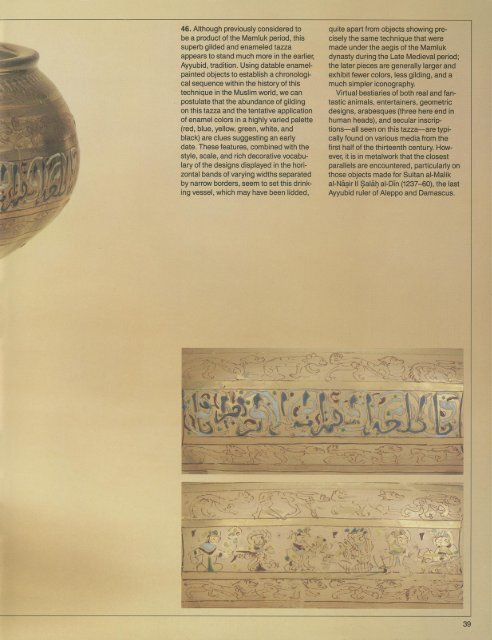R - Metropolitan Museum of Art
R - Metropolitan Museum of Art
R - Metropolitan Museum of Art
You also want an ePaper? Increase the reach of your titles
YUMPU automatically turns print PDFs into web optimized ePapers that Google loves.
46. Although previously considered to<br />
be a product <strong>of</strong> the Mamluk period, this<br />
superb gilded and enameled tazza<br />
appears to stand much more in the earlier,<br />
Ayyubid, tradition. Using datable enamelpainted<br />
objects to establish a chronological<br />
sequence within the history <strong>of</strong> this<br />
technique in the Muslim world, we can<br />
postulate that the abundance <strong>of</strong> gilding<br />
on this tazza and the tentative application<br />
<strong>of</strong> enamel colors in a highly varied palette<br />
(red, blue, yellow, green, white, and<br />
black) are clues suggesting an early<br />
date. These features, combined with the<br />
style, scale, and rich decorative vocabulary<br />
<strong>of</strong> the designs displayed in the horizontal<br />
bands <strong>of</strong> varying widths separated<br />
by narrow borders, seem to set this drinking<br />
vessel, which may have been lidded,<br />
quite apart from objects showing precisely<br />
the same technique that were<br />
made under the aegis <strong>of</strong> the Mamluk<br />
dynasty during the Late Medieval period;<br />
the later pieces are generally larger and<br />
exhibit fewer colors, less gilding, and a<br />
much simpler iconography.<br />
Virtual bestiaries <strong>of</strong> both real and fantastic<br />
animals, entertainers, geometric<br />
designs, arabesques (three here end in<br />
human heads), and secular inscriptions-all<br />
seen on this tazza-are typically<br />
found on various media from the<br />
first half <strong>of</strong> the thirteenth century. However,<br />
it is in metalwork that the closest<br />
parallels are encountered, particularly on<br />
those objects made for Sultan al-Malik<br />
al-Nasir II Salah al-Din (1237-60), the last<br />
Ayyubid ruler <strong>of</strong> Aleppo and Damascus.<br />
*<br />
p Sffffe;- ,, . ..., , ---'<br />
^^^t:. .(,s -j- t~ -^--^ '^ ^^<br />

















